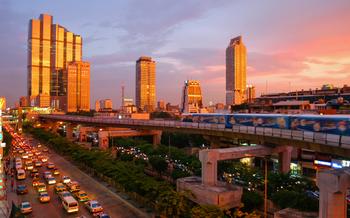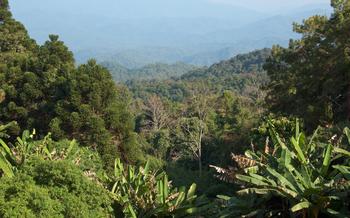
Prince of Chumphon Shrine
- Prince of Chumphon Shrine: A Historical Legacy
- Paying Respects: Shrine Etiquette
- Exploring the Shrine Grounds
- Interactive Displays and Exhibitions
- Annual Festivals and Events: A Cultural Mosaic
- Surrounding Attractions: A Cultural Mosaic
- Getting There: A Seamless Journey
- Accommodation and Dining: Nearby Options
- Local Customs and Traditions: A Respectful Encounter
- Photography and Social Media Etiquette
- Accessibility Features: Ensuring Inclusivity
- Sustainable Tourism: A Responsible Approach
- Health and Safety Considerations: A Secure Experience
- Insider Tip: A Glimpse into the Unknown
Prince of Chumphon Shrine: A Historical Legacy
The Prince of Chumphon Shrine, located in the southern Thai province of Chumphon, holds a significant place in Thailand's history and culture. Dedicated to Prince Chumphon, a revered naval commander, and statesman, the shrine serves as a tribute to his achievements and contributions to the nation.
The shrine's architectural design is a blend of traditional Thai and naval influences, reflecting Prince Chumphon's dual roles as a naval officer and a member of the royal family. The main shrine building features intricate carvings, colorful murals, and a towering spire, while the surrounding grounds are adorned with cannons, anchors, and other naval artifacts.
Beyond its historical significance, the shrine holds immense importance for the local community. It is a place of reverence and remembrance, where people come to pay their respects to Prince Chumphon and seek blessings for their own lives. The shrine also plays a crucial role in preserving Thai culture and naval traditions, serving as a reminder of the nation's rich maritime heritage.
Paying Respects: Shrine Etiquette
Respectful Attire and Behavior:
When visiting the Prince of Chumphon Shrine, respectful attire and behavior are essential. Visitors should dress modestly, covering their shoulders and knees. Shoes must be removed before entering the shrine's main prayer hall. Maintaining a quiet and solemn demeanor is expected, showing reverence for the sacred space.
Offerings and Donations:
Devotees often make offerings to the shrine as a way of showing gratitude and seeking blessings. These offerings can include flowers, candles, incense sticks, or food items. Visitors can purchase these offerings from vendors outside the shrine or bring their own. Donations in cash are also accepted and used to maintain the shrine and support its activities.
Lighting Incense and Making Merit:
Lighting incense sticks and making merit are common practices at the shrine. Visitors can light incense sticks at the designated incense burners and place them in the incense pots provided. Making merit involves offering coins or banknotes to the shrine's donation boxes, which are located throughout the complex. This act is believed to bring good fortune and blessings.
Seeking Blessings and Guidance:
Many visitors come to the shrine to seek blessings and guidance from the revered Prince of Chumphon. They may pray or meditate at the shrine's altar, offering their intentions and requests. Some visitors also choose to light candles and make offerings, asking for specific blessings or protection. The shrine is a place where devotees can connect with their spiritual beliefs and find solace and guidance.
Exploring the Shrine Grounds
The Prince of Chumphon Shrine is a sprawling complex that offers a serene and contemplative environment. Visitors can explore the various areas of the shrine to gain a deeper understanding of Prince Chumphon's life and legacy, as well as Thai naval history.
The shrine complex features a central courtyard surrounded by several buildings, including the main shrine hall, a museum, and a library. The main shrine hall houses a bronze statue of Prince Chumphon, which is adorned with flowers and offerings from devotees. Visitors can pay their respects and offer prayers to the prince, seeking blessings and guidance.
Within the shrine complex, there are designated areas for reflection and meditation. Visitors can find tranquil spots to sit in silence, contemplate the teachings of Prince Chumphon, and connect with their inner selves. The serene atmosphere of the shrine encourages visitors to slow down, appreciate the present moment, and find inner peace.
The shrine grounds are also adorned with sculptures and statues of historical figures, each with a story to tell. Visitors can admire the intricate details of these artworks and learn about the individuals who played significant roles in Thai history. The presence of these statues adds a touch of grandeur and historical significance to the shrine complex.
Finally, the gardens and landscaping within the shrine are meticulously maintained and offer a feast for the eyes. Visitors can stroll through the lush greenery, appreciate the vibrant colors of the flowers, and enjoy the tranquility of the natural surroundings. The gardens provide a harmonious balance to the architectural features of the shrine, creating a serene and inviting environment for visitors to explore and pay their respects.
Interactive Displays and Exhibitions
The Prince of Chumphon Shrine offers a range of interactive displays and exhibitions that provide visitors with a deeper understanding of Prince of Chumphon's life and achievements, as well as Thailand's rich naval history. Through multimedia exhibits, visitors can explore the various stages of Prince of Chumphon's illustrious career, from his early days as a naval cadet to his rise as a renowned admiral. Interactive displays on Thai naval history showcase key battles, technological advancements, and the pivotal role of the navy in shaping the nation's maritime heritage.
Educational programs are designed for visitors of all ages, making the shrine an ideal destination for families and school groups. Children can engage in hands-on activities and games that teach them about naval science, maritime exploration, and the importance of preserving Thailand's naval legacy. Workshops and cultural activities are also organized regularly, providing opportunities for visitors to learn traditional arts and crafts, participate in Thai dance and music performances, and gain insights into Thai culture and traditions.
Annual Festivals and Events: A Cultural Mosaic
The Prince of Chumphon Shrine is not only a place of reverence but also a vibrant hub for cultural celebrations. Throughout the year, the shrine hosts a variety of festivals and events that honor Prince of Chumphon's legacy and showcase Thailand's rich cultural heritage.
One of the most significant events is the annual Prince of Chumphon Day, held on May 19th. This day commemorates the prince's birthday and features grand ceremonies, parades, and traditional Thai performances. Devotees from all over the country gather at the shrine to pay their respects and participate in the festivities.
Other notable events include the Songkran Festival, which marks the Thai New Year, and the Kathin Festival, which celebrates the offering of new robes to monks. These festivals are a joyous occasion, filled with colorful processions, music, and dancing. Visitors can immerse themselves in the vibrant Thai culture and experience the warmth and hospitality of the local community.
Additionally, the shrine regularly hosts educational and cultural programs, workshops, and exhibitions. These events provide an opportunity for visitors to learn more about Prince of Chumphon's life and achievements, as well as Thailand's naval history and maritime heritage. By participating in these events, visitors can gain a deeper understanding of Thai culture and traditions.
Surrounding Attractions: A Cultural Mosaic
Beyond the Prince of Chumphon Shrine, the surrounding area is a treasure trove of cultural and historical gems. A short walk away, visitors can explore the majestic Chumphon Cathedral, a stunning example of neo-Gothic architecture, or delve into the fascinating exhibits at the Chumphon National Museum, showcasing the region's rich heritage.
Strolling through the vibrant local markets, visitors can immerse themselves in the sights, sounds, and flavors of traditional Thai culture. From bustling seafood markets to colorful handicraft stalls, there's something for every traveler to discover. Indulge in the tantalizing aromas of street food vendors, savoring the delectable flavors of authentic Thai cuisine.
For those seeking a deeper connection with nature, the nearby Khao Ngon Nak National Park offers a serene escape. Hike through lush rainforests, encounter exotic wildlife, and admire breathtaking views from the park's viewpoints. Alternatively, embark on a leisurely boat tour along the scenic Chumphon River, soaking in the tranquil beauty of the surrounding landscapes.
Getting There: A Seamless Journey
Accessibility by Road, Rail, and Air
Reaching the Prince of Chumphon Shrine is a breeze, thanks to its convenient location and accessible transportation options. For those traveling by road, the shrine is situated along the picturesque coastal route of Highway 41, which offers a scenic journey through Thailand's beautiful landscape. Alternatively, visitors can take the train, with the nearest station being Chumphon Railway Station, located approximately 10 kilometers from the shrine. For those arriving by air, Chumphon Airport provides domestic flights from major cities in Thailand, and taxis or rental cars are readily available for the short trip to the shrine.
Public Transportation Options to the Shrine
For those relying on public transportation, getting to the shrine is equally convenient. Local buses and songthaews (shared taxis) regularly ply the route between Chumphon town and the shrine, offering affordable and hassle-free travel. The journey takes approximately 30 minutes, and buses or songthaews can be easily hailed from various points in the city.
Guided Tours and Private Transportation Services
For a more comprehensive and personalized experience, guided tours to the Prince of Chumphon Shrine are readily available. These tours often include round-trip transportation from your hotel, as well as informative commentary from a knowledgeable guide. Private transportation services, such as taxis or rental cars, offer flexibility and convenience, allowing visitors to set their own pace and explore the shrine at their leisure.
Tips for Planning a Hassle-Free Visit
To ensure a smooth and enjoyable visit to the Prince of Chumphon Shrine, it is advisable to plan ahead and consider the following tips:
- Check transportation schedules in advance: Public transportation in Thailand can be subject to changes or delays, so it is recommended to check bus or train schedules before your visit.
- Consider guided tours for a deeper experience: Guided tours not only provide convenient transportation but also offer insights and historical context that can greatly enhance your visit.
- Book private transportation for convenience: If you prefer the flexibility of setting your own itinerary and exploring at your own pace, renting a car or hiring a private taxi is a great option.
Accommodation and Dining: Nearby Options
Accommodation
The Prince of Chumphon Shrine is surrounded by a range of accommodation options to suit various budgets and preferences. From budget-friendly guesthouses to comfortable hotels, visitors can find a place to stay that fits their needs and budget. Many of the accommodations offer traditional Thai-style rooms with wooden furnishings, while others provide more modern amenities.
Dining
Visitors to the Prince of Chumphon Shrine can savor the delights of Thai cuisine at the many local restaurants in the area. From street food stalls serving up mouthwatering Pad Thai and Som Tum to cozy eateries offering authentic Thai curries and seafood dishes, there are plenty of options to satisfy every palate. Local markets also offer a variety of fresh produce, snacks, and beverages, providing an opportunity to sample local flavors and support the community.
Recommendations
For a budget-friendly option, the Chumphon Princess Hotel offers basic yet comfortable rooms within walking distance of the shrine. The Sea Breeze Resort, located a short drive away, provides a more upscale experience with spacious rooms and stunning sea views. For those seeking a unique stay, the Baan Talay Nok Homestay offers charming wooden bungalows right on the beach, just a short boat ride from the shrine.
Local Customs and Traditions: A Respectful Encounter
As you embark on your journey to the Prince of Chumphon Shrine, it is essential to approach the local customs and traditions with respect and understanding. Thailand is a country rich in cultural heritage, and its people are known for their warm hospitality. Here are some tips to help you interact with the local community respectfully:
Greetings and Etiquette: When meeting Thai people, it is customary to wai, a gesture of greeting and respect. Hold your hands together in a prayer-like position in front of your chest and bow your head slightly.
Appropriate Dress: While Thailand is generally relaxed about dress codes, it is recommended to dress modestly when visiting religious sites. Avoid shorts, tank tops, and revealing clothing, especially for women.
Respecting the Monarchy: The Thai monarchy holds a revered position in the country. It is considered disrespectful to make negative comments about the King or the Royal Family.
Interacting with Monks: Monks are highly respected in Thailand, and it is important to show them deference. Avoid touching or making physical contact with monks, and always address them with the appropriate titles.
Tipping Culture: Tipping is not as prevalent in Thailand as in some other countries, but it is becoming more common in tourist areas. If you receive exceptional service, a small tip is appreciated.
By understanding and respecting local customs, you can ensure a positive and enriching encounter with the Thai community. Embracing the local culture will enhance your experience and contribute to a deeper appreciation of Thailand's unique identity.
Photography and Social Media Etiquette
Respecting the Sacred Space: When capturing the beauty of the Prince of Chumphon Shrine through photography, it's crucial to maintain a respectful demeanor. Avoid using flash photography, as it can be disruptive to other visitors and may damage the shrine's delicate artifacts. Remember that the shrine is a place of worship and reflection, so silence and mindfulness should be observed.
Privacy and Consent: Before photographing or filming other visitors, always ask for their consent. This shows respect for their privacy and ensures they feel comfortable in the sacred space. When in doubt, it's best to refrain from taking photos of individuals without their permission.
Social Media Responsibility: While sharing your experiences at the shrine on social media platforms is encouraged, it's important to do so responsibly. Be mindful of the privacy of others and avoid posting any personal information or images of individuals without their consent. Always credit the shrine appropriately and use relevant hashtags to help promote this sacred site to a wider audience.
Honoring Local Customs: When taking photos or videos at the shrine, be mindful of local customs and traditions. Avoid posing in front of religious iconography or sacred objects in a disrespectful manner. Dress appropriately and maintain a respectful demeanor throughout your visit.
Accessibility Features: Ensuring Inclusivity
The Prince of Chumphon Shrine is committed to creating an inclusive environment that welcomes visitors of all abilities. Accessibility features have been carefully implemented to ensure that everyone can fully experience the shrine's cultural and historical significance. Wheelchair ramps, elevators, and accessible parking spaces are available for visitors with mobility challenges. Visitors with special needs can request assistance from the shrine's staff, who are trained to provide support and guidance. Braille signage and audio guides are also available to enhance the experience for visually impaired visitors. By making these accessibility features a priority, the shrine demonstrates its commitment to inclusivity and ensures that all visitors can enjoy a fulfilling and meaningful experience.
Sustainable Tourism: A Responsible Approach
As responsible travelers, it is essential to embrace sustainable tourism practices when visiting the Prince of Chumphon Shrine. By doing so, we can minimize our environmental impact and support the local community. Here are some tips for sustainable tourism:
-
Reduce Plastic Waste: Avoid single-use plastic items such as water bottles and plastic bags. Bring your own reusable water bottle and shopping bags to reduce plastic pollution.
-
Respect the Environment: Be mindful of your surroundings and avoid littering or damaging the natural environment. Dispose of waste properly in designated bins.
-
Support Local Businesses: Choose to stay in locally-owned guesthouses, eat at traditional Thai restaurants, and shop at local markets. This helps to support the local economy and preserve traditional livelihoods.
-
Engage with the Community: Take the time to interact with the local community, learn about their culture, and support local initiatives. This fosters cultural exchange and promotes mutual understanding.
-
Protect Marine Life: If you participate in water activities, be mindful of marine life and avoid disturbing coral reefs or marine ecosystems. Choose tour operators that prioritize sustainable practices.
By practicing sustainable tourism, we can help preserve the natural and cultural heritage of the Prince of Chumphon Shrine while contributing to the well-being of the local community.
Health and Safety Considerations: A Secure Experience
Visiting the Prince of Chumphon Shrine is generally safe, but it's essential to take certain precautions to ensure a healthy and enjoyable experience.
- General Health and Safety Tips:
- Stay hydrated, especially in hot weather.
- Protect yourself from the sun with sunscreen, sunglasses, and a hat.
- Wear comfortable shoes as you'll be doing a lot of walking.
-
Be aware of your surroundings and belongings.
-
Precautions Against Common Illnesses and Hazards:
- Take necessary vaccinations and medications before your trip.
- Avoid consuming raw or undercooked food and water.
- Practice good hygiene, such as washing your hands frequently.
-
Be cautious of insects and animals, especially during the rainy season.
-
Emergency Contact Information and Medical Facilities:
- Keep emergency contact information handy.
- Familiarize yourself with the nearest medical facilities and their contact details.
- Carry a first-aid kit for minor injuries or ailments.
Remember, by following these simple precautions, you can minimize risks and create a safe and enjoyable visit to the Prince of Chumphon Shrine.
Insider Tip: A Glimpse into the Unknown
Step off the beaten path and discover the hidden treasures within the Prince of Chumphon Shrine. Explore the serene gardens, where you'll find a secluded meditation spot nestled amidst tropical flora. As you wander through the shrine complex, keep an eye out for the ancient banyan tree, said to be over a century old. Its gnarled roots and sprawling branches create a mystical aura, inviting you to pause and reflect.
Delve deeper into the shrine's history by engaging with the local community. Ask the friendly monks or shrine officials about lesser-known stories and legends surrounding Prince of Chumphon. They might share tales of his bravery, his naval exploits, or his contributions to Thai culture.
For a truly immersive experience, participate in one of the shrine's many workshops or cultural activities. Learn the art of traditional Thai dance, create your own amulet, or join a meditation session. These activities offer a unique opportunity to connect with the local culture and gain a deeper understanding of the shrine's significance.




